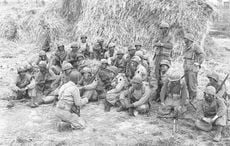The poor scribes of yore who were spiritual calligraphers and illuminators of Ireland's most famous book, many housed in Trinity College Dublin, the monks and scholars of Ireland.
Ah, June! The sun is shining, the birds are singing, tulips are in bloom and the smell of sun cream fills the air (at least for a day!). Summer has officially arrived in Ireland and while students are giving out about the long hours cloistered in dark stuffy rooms, studying for and writing exams, pity the poor scribes of yore who spent hours, months and even years engaged in the practice of writing and illustrating the famous Book of Kells and similar medieval manuscripts. What student would not sympathize with the beleaguered monk who wrote the following at the end of a session: "Now I've written the whole thing: for Christ's sake give me a drink."

The Book of Kells.
If you are not familiar with the Book of Kells, sometimes called the world’s most famous book, this 8th century illuminated gospel is held by Trinity College Dublin, where it has lived permanently since being donated by the Bishop of Meath in 1661. Every day, two pages are on display to the public for a fee (book your visit online or be prepared for a considerable wait).
If you’re not able to see the manuscript in person, you can visit it online, in its entirety, courtesy of TCD here. Also, for a limited time, other early medieval Irish manuscripts, including the famous “Book of Armagh” are on display in the Long Room Library at the College. This exhibit is also available for viewing online here.

The Long Room in Trinity College.
The scriptorium was an essential part of many medieval monasteries particularly insular monasteries, such as those at Iona in Scotland and at Kells in County Meath, where it is conjectured the Book of Kells was painstakingly wrought. It may be easy for us, looking at these beautiful illuminated manuscripts, to romanticize the lives of the monks who wrote or illuminated them, but, in fact, the work was so harsh that it was considered at the time to be manual labour on the same level as agricultural fieldwork or building construction. The work was so fine and detailed that many scribes went blind from the poor light and long hours of copying required.
Read more: Inside Trinity's Long Room library - more magical than Hogwarts
Much of what we know about the daily lives of these spiritual calligraphers and illuminators can be found, not in the texts themselves. but in the margins. In words and pictures these medieval whingers expressed their true feelings about the life of a medieval scribe. In an issue of Lapham’s Quarterly, writer Colin Dickey, collected some of the most telling, and now at a distance, amusing complaints discovered on the vellum edges:
“The parchment is hairy.” “The ink is thin.” “Writing is excessive drudgery. It crooks your back, it dims your sight, it twists your stomach and your sides.” This lament, “As the harbor is welcome to the sailor, so is the last line to the scribe.” And this plea, “St. Patrick of Armagh, deliver me from writing.”
In other cases, bizarre, grotesque and often childish doodles populate the margins, including a bagpipe playing monkey, disembodied genitalia, strange hybrid animals, naked monks and nuns. Whether these were all done by bored scribes, or later by children who gained access to the books is not known, but as Carl Pyrdum, author and medieval scholar pointed out, in “Medieval Doodles, A Quick Primer”, “See, the thing about medieval doodles is they look just like modern doodles.”
Gazing in awe at the knots and swirls, intricate figures and grand designs of these medieval treasures, it’s easy to imagine they were the creation of angels, but when we look a little closer, at the earthly margins, we can relate, as every poor student can, to these all too human scholars of the past, hunched over their books, cold, hungry, tired and praying for deliverance.
Read more: Trinity reveal eight rare and fascinating ancient manuscripts online
This article was submitted to the IrishCentral contributors network by a member of the global Irish community. To become an IrishCentral contributor click here.




Comments